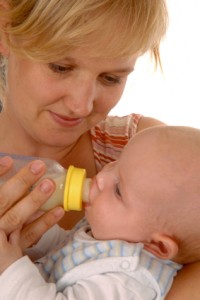Unlike breastfeeding, we’ve all seen bottle feeding, and we all know how to do it. We’ve been surrounded by it growing up. If someone handed you a baby and a bottle you would know what to do right? Of course you would, but would you know how to do it without causing a stressful feeding? Despite the large number of parents who use bottles in today’s society (whether those bottles contain breastmilk or formula), there are very few who have actually been taught how to bottle feed their baby in a manner that is respectful of the baby’s airway and natural feeding rhythm.
Bottle feeding may seem like a strange topic for a lactation consultant to be blogging about, but I feel it’s an important one. Conventional bottle feeding methods can cause problems for both breastfed and bottle fed babies, and all babies deserve to be fed in a respectful manner. By “conventional” bottle feeding, I mean the method of bottle feeding that most of us are used to, which is baby more or less on his back, and the bottle being tipped up to ensure there are no air bubbles.
Although I work with breastfeeding moms and babies, I do a lot of teaching about bottle feeding. The moms that come to me, are usually having difficulty with breastfeeding, and are sometimes supplementing breastfeeding with bottles of expressed milk or formula. There are of course alternate methods of supplementing (supplemental nursing system, finger, syringe or cup feeding) but many moms are either already using bottles when I see them, or find that bottles are simply easier to deal with because they are familiar.
I often hear from moms who are afraid that they aren’t producing enough milk because their baby will gulp down a bottle after breastfeeding. It’s important for parents to understand that with conventional bottle feeding methods, babies have no choice but to gulp down everything in their bottle in order to protect their airway. If you hold a bottle upside down (even one with a slow flow nipple), it drips. When a baby being given a bottle swallows, the negative pressure created draws more milk into the baby’s mouth, meaning the baby has to swallow again to avoid choking. This is stressful for the baby, and babies will often display stress cues such as splayed fingers or toes, milk running out of the corner of the baby’s mouth, trying to turn their head away, or trying to push the bottle away. The picture above is a good example of this.
It’s not normal for babies to gulp down their entire feeding in a few minutes. When you watch a baby breastfeeding, you see that they drink for a while then take a little break before drinking again (with the exception perhaps of oversupply/forceful let down, which is a different situation). Breastfeeding is the biological norm for infant feeding. This means that with any other feeding method used, care should be taken to mimic breastfeeding as much as possible. I have seen conventional bottle feeding methods lead to overfeeding, spitting up, reflux, wheezing and difficulty breathing while feeding, and even feeding refusal (due to feeding being so stressful). Bottles being given to a breastfed baby can also cause problems with breastfeeding. Babies suck differently from a bottle than they do at the breast, and babies can become accustomed to the faster flow of milk from a bottle, causing them to become impatient at the breast. The tips below can help to minimize some of the problems associated with bottle feeding.
Tips for bottle feeding any baby (not just a breastfed one!)
1. Hold your baby sitting upright, and start by placing the nipple of the bottle against your baby’s top lip. Wait for your baby to open up before putting the bottle in his mouth. Never force a bottle into a baby’s mouth.
2. Your baby should be sitting up enough that the bottle is horizontal (parallel to the floor). Tip the bottle just enough to keep the tip of the nipple filled with milk (as the bottle empties, you will have to tip the bottle up more). It’s fine if there is an air bubble at the base of the nipple as long as the tip is filled with milk. This works much better with a straight bottle rather than an angled one.
3. If you are supplementing a breastfed baby, or pumping and bottle feeding in the hopes of getting baby back to nursing, it is beneficial to let your baby suck on the nipple for a minute or two without getting anything, and then tip the bottle so your baby is getting milk. When breastfeeding, babies have to wait a minute or so for mom’s milk to let down, and they have to suck to trigger that let down. Babies who have been bottle fed sometimes get used to the immediate reward from the bottle and then are impatient at the breast and don’t want to wait for let down. By letting baby suck for a short while without getting anything from the bottle, you are mimicking the process at the breast, and it can help with the transition. There is no need to worry about your baby taking in air, one end or the other it will come back out!
4. Watch your baby’s cues All babies, whether breast or bottle fed should be fed whenever they show signs of being hungry, and not according to any kind of schedule. During feeding, if your baby starts to show any signs of stress (splayed fingers and toes, milk spilling out of mouth, turning head away, pushing bottle away – see picture above) then your baby needs a break. Keep the bottle in your baby’s mouth, but tip the bottle so that the nipple is pointing towards the roof of the baby’s mouth. By doing this, your baby knows that the bottle is still there and will start sucking again when ready. At that point you can tip the bottle back up so that baby is again getting milk. It is frustrating for your baby if you take the bottle out of his mouth to give him a break because he doesn’t know where it has gone or if it’s coming back. If your baby is showing signs that he is done (turning head, trying to push bottle away etc), then respect those cues and end the feeding.
5. Alternate sides part way through the feeding to mimic breastfeeding and allow stimulation to both eyes and both sides of the body. This also helps to prevent the development of a side preference when feeding.
6. Find a nipple that works well for your baby. There are no black and white answers as to which bottle nipple is “best” for a breastfed baby, because all babies are different. For young babies, make sure you are using a slow flow nipple. Even with older babies a slow flow nipple may be best if your baby is struggling with the flow of milk. Don’t worry about the recommended ages on the bottle nipple packaging, watch your baby to determine what works best for them. Unfortunately, “slow flow” is not something that is standardized, and some “slow flow” nipples actually flow quite quickly, so again, watch your baby. I do not recommend the “Nuk” or orthodontic type nipples because mom’s nipples don’t look like that! (If mom’s nipples are pinched or flattened after baby feeds, it’s a sign that baby isn’t latched on properly, or some other issue is causing baby to compress the nipple). Your baby should be able to “latch” onto the base of whichever nipple you use. Some bottle nipples that are advertised as having a wide base and being “more like mom’s breast”, are so wide that baby ends up being just on the nipple, which is something to be avoided. There are some good pictures of how your baby should look when latched onto a bottle nipple on this post from Best for Babes titled How to Bottle-feed as You’d Breastfeed, and more information at the website www.breastandbottlefeeding.com.
Things to avoid:
1. Never prop a bottle. It’s a dangerous practice that is stressful for your baby.
2. Don’t bottle feed your baby while he’s swaddled. You need to be able to see your baby’s hands to watch for stress signs, and your baby needs to have his hands free to participate in feeding.
3. Don’t feed your baby with him facing away from you. Feeding is an important time for the development of social interaction in babies. Make eye contact with your baby, talk to him and enjoy the feeding as a fun interaction with your baby rather than another task to get through as quickly as possible.
4. Don’t force your baby to finish a bottle by twisting it or moving it around in baby’s mouth. Let your baby decide when he’s done. Overfeeding can lead to an uncomfortable and unhappy baby!
More information about the baby-led method of bottle feeding can be found in Dee Kassing’s article Bottle-Feeding as a Tool to Reinforce Breastfeeding
Use of formula
Along with bottle feeding, I also do a lot of teaching about correct formula preparation because many parents are not informed about the dangers of giving powdered formula to young or ill babies, and haven’t been taught how to prepare powdered formula properly.
Powdered infant formula is not a sterile product and there have been cases of powdered formula being contaminated with the bacteria E. sakazakii which can easily be fatal for young children. Babies under the age of one year are at particular risk of infection with E. sakazakii, with the greatest risk being for those who are less than 28 days old, or who are preterm, low birth weight, or immunocompromised (have a weakened immune system). For these babies, liquid formula should be used because it is sterile.
If you are using powdered formula it is very important for it to be properly prepared in order to kill any potential bacteria. Powdered formula needs to be mixed with water that is at least than 70 degrees Celsius (boil the water and let it cool for no more than 30 minutes before mixing it with the powder). It can then be cooled to an appropriate temperature for feeding or cooled and stored in the fridge for no more than 24hrs. You can read more detailed information about the proper preparation of powdered infant formula here.
If you are using liquid formula, make sure you follow the directions on the can closely. There are two types of liquid formula – ready to feed and liquid concentrate. The liquid concentrate must be mixed with the proper amount of water (as outlined on the can) before feeding. Failure to mix liquid concentrate formula with the right amount of water can have severe consequences for your baby.


